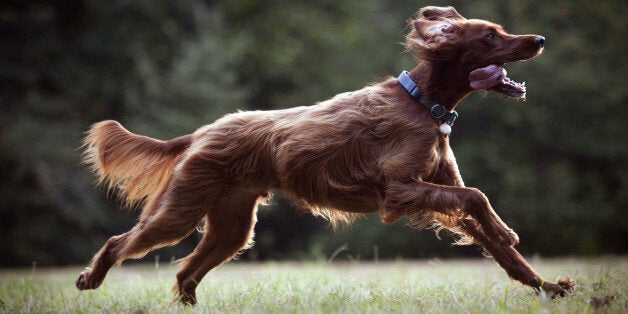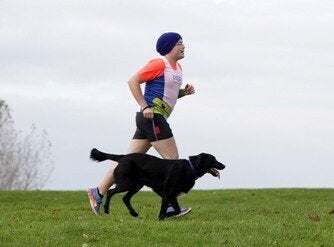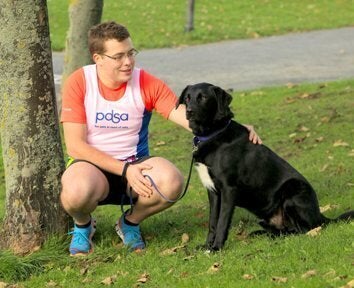
I've got a special interest in dog exercise as it's an important part of weight control. Dogs need to exercise every day to make sure they're healthy, as well as being happy through mental stimulation.
Dogs love exercise and play, and I've always felt it's a win-win situation: you both get exercise and, at the same time, build up a special bond with your dog.
So how much exercise does your dog need? It varies based on age, breed, size and overall health. Your vet can advise you about this but, on average, an energetic type dog (like a border collie) at the peak of fitness will need about 30 minutes of vigorous exercise plus one to two hours' walking each day. Often I find owners underestimate their dog's needs and their mouths drop open when I share information like this with them!

So the vital first stage in transforming your dog from couch potato to marathon runner is making an appointment with your vet, who can do a health check to see what would be best for your dog.
For example, a senior dog shouldn't be pushed too hard, while sustained jogging isn't good for a puppy's joints. Short-nosed dogs, like bulldogs, may have trouble breathing if they are exercised too hard, so frequent, short walks may well be better for them.
Remember, there's a difference between a gentle stroll with your dog and the intensive exercise used to reach peak fitness - but don't exclude these gentle strolls. Use a different lead or coat for the stroll and the work-out to remind you and your dog what you're going to do. Always do a five minute warm-up session at the beginning of the exercise, a steady walk to get the muscles working, and a similar cooling-down session at the end.
Varied walking is useful as well. That's where you speed walk for about 30 seconds, then slow down for a while, before speeding up once more. Do this randomly throughout your walk, but remember to work at your dog's pace. Don't push your dog too hard, but then if they show no signs of exertion, or are still full of pent-up energy when you get home, they probably aren't getting enough exercise!
Dogs love games but avoid throwing sticks and small balls as they can cause injuries or get stuck in a dog's throat. My favourite is the special dog toy rubber discs that you can throw. See if friends can join in with throwing safe toys for your dog to enjoy.
When we do get to enjoy warm weather, it's best not to walk your dog at the hottest time of the day. Make sure that any vigorous exercise is done when it is cooler, such as early in the morning, or later on in the evening.
Make sure your dog has plenty of water breaks, drinking small amounts frequently both during the walk and when you get home to make sure there's no danger of dehydration. Don't let your dog drink lots of water all at once, or feed your dog a big meal immediately before or after exercise. It can lead to serious and painful stomach conditions.
And finally... don't forget the vital 'sniff breaks' so your dog has a truly wonderful day!

One person who is a real inspiration for me is one of my veterinary colleagues, Matt, who's running the London Marathon for PDSA on 13 April 2014. His dog, Bertie, looks the absolute peak of fitness as Matt regularly goes on shorter practice runs with him. You can donate towards both of their efforts online. Find out more about our marathon runners at www.pdsa.org.uk/marathon.